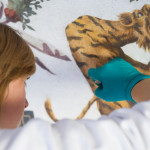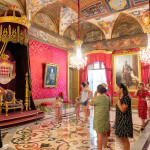Almost a decade of restoration and conservation works at the Palais Princier de Monaco will come to fruition next month with the grand reopening to the public set for 2nd April. Amongst the treasures that await visitors are a series of spectacular 16th century frescoes in the Throne Room, which have been painstakingly restored to their former glory.
Since last October, the Prince’s Palace of Monaco has been closed to the public. That is all about to change as the Palace has announced it will be reopening its doors on 2nd April to reveal some of the results of almost ten years’ worth of work, including the incredible restoration of 16th century frescoes, which had lain hidden beneath paint and plaster or had been clumsily repainted over time.
A team of 17 expert restorers have been hard at work, cleaning back the frescoes a square centimetre at a time. They do not expect to be completely finished by the April reopening, but there is a goal in mind.
“We have to deliver La Salle at the end of July for an event scheduled for September,” restoration team member Marion Jaulin told Monaco Matin. “No doubt it won’t be completely finished, but we have to move forward as much as possible, the whole team is mobilised, and we will probably recruit two additional people to honour this deadline.”
The job is painstaking; all done by hand and using only small tools for the delicate work. The centrepiece of the room, which was exposed between 2020 and 2022, is of Ulysses as he watches over his troops. A zodiac motif has also been found in the vaults; an exciting addition to the room’s overall charm.
A meticulous method that paves the way for future generations and techniques
The current team is fixing damage in plaster and glass, removing inelegant prior attempts at fresco and frieze repairs, and making hanging decorations look like new.
“Our work has been de-restoring in order to re-restore and today we can attack the pictorial reintegration,” Jaulin explained.
Yannick Bouillon, another of the restorers, added, “In some places, we found holes up to three centimetres deep, which we filled in with traditional masonry… Fine and smooth plaster like the original and without sanding. Sanding does not work very well with old-fashioned coatings; you have to have the perfect level right away that you adjust in the cool with water and with a sponge to smooth and do the entire finish.”
To give harmony to the overall piece, a method of filling in the cuts and holes is used by painting these areas in a shade just a hair off the original, giving the illusion from below that it is untouched. Interestingly, it is all being done in watercolour, which means it can be “erased” quite easily.
“With a wipe of the sponge, our work can be removed to leave the field free to other generations [and] for new restorations with new techniques in the future,” said Jaulin.
Sadly, some of the frescoes are too damaged to be saved, but in these cases, the team is considering using mobile panels that depict the ruined scenes as closely as possible.
The throne itself is also getting a makeover, with a canopy and other elements being cleaned and made perfect. This will be put back in place on 20th March in good time for the April reopening.
The team has also been on the lookout for clues as to who exactly the artist of such magnificent creations was. A 1547 receipt addressed to a Raphael acolyte, Nicolosio Granello, has solved at least part of the mystery, with experts agreeing that the Genoese painter’s style is indeed in line what they have found.
The public will be able to get a partial glimpse into all this hard work at the reopening, when they can also enjoy resumption of visits to the various state apartments of the Palace.
Sign up for the Monaco Life newsletter. For the latest news, follow us on Facebook, Twitter, and Instagram.
Photos courtesy of Maël Voyer Gadin at the Palais Princier de Monaco



